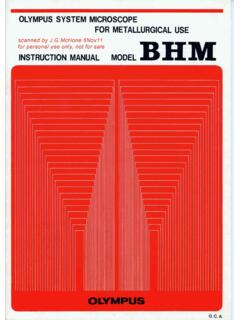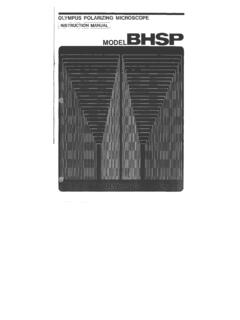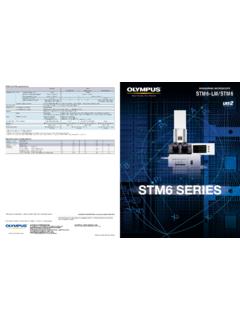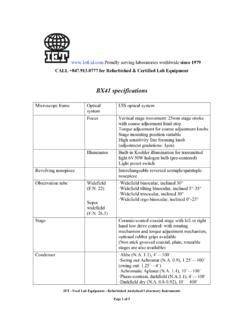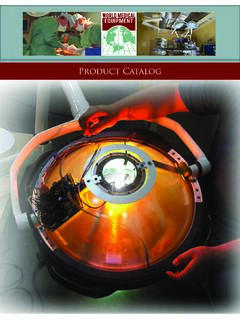Transcription of OLYMPUS SYSTEM MICROSCOPE BHT - Alan Wood
1 OLYMPUS SYSTEM MICROSCOPE Model BHT OLYMPUS This instruction manual has been written for the use of the OLYMPUS SYSTEM MICROSCOPE Model BHT. It is recommended that you read the manual carefully in order to familiarize yourself fully with the use of the MICROSCOPE , so that you can obtain optimum performance from it. IMPORTANT 0 bserve the following points carefully: Operation 1. Always handle the MICROSCOPE with the care it deserves, and avoid abrupt motions. 2. Avoid the use and maintenance of the MICROSCOPE in direct sunlight, high temperature and humidity, dust and vibration. 3. Only use the tension adjustment ring for altering the tension of the coarse adjustment knobs.
2 (Do not twist the two coarse adjustment knobs in opposite directions simultaneous- ly, as this will cause damage.) 4. Make sure that the voltage selector switch on the base plate is set to conform with the local mains voltage. 5. Make it a point of grounding the MICROSCOPE to prevent electric accidents. Maintenance 1. Lenses must always be kept clean. Carefully wlpe off oil or fingerprints deposited on the lens surfaces with gauze moistened with a small amount of xylene, alcohol or ether. 2. Do not use organic solutions to wipe the surfaces of various components. Plastic parts, especially, should be cleaned with neutral detergent. 3. Never disassemble the MICROSCOPE for repair.
3 Only authorized OLYMPUS service personnel should make repairs. 4. The MICROSCOPE should be covered with the vinyl dust cover provided and stored in a place free from humidity and fungi. For extended storage it is recommended to keep objectives and eyepieces in desiccators, containing desiccants such as silica gel. CONTENTS .. STANDARD EQUIPMENT II. NOMENCLATURE Ill. ASSEMBLY .. IV. IDENTIFICATION AND FUNCTION OF VARIOUS COMPOhlENTS .. V. OPERATION .. A. Switching on the Light Source 1 voltage Adjustment and Light Intensity I B. Placement of a Specimen Slide pizGq .. kwecimen Slide 1 .. C. Observation Tube 1. lnterpupillary Distance Adjustment 2. Diopter Adjustment 3.
4 Light Path Selector D. Condenser Adjustment . 1. Condenser Centration Field lris Diaphragm I Aperture lris Diaphragm I E. Focusing Adjustment .. 1. Tension of Coarse Adjustment Knobs and Fine Adjustment l~se of Rubber Cap for Fine Adjustment Knob / 2. Pre-Focusing Lever 3. Adjustment of Stage Block Height F. Use of Immersion Objectives .. G. Photomicrography VI. OPTICAL DATA VII. TROUBLESHOOTING .. I. STANDARD EQUIPMENT Component Model I Line cord UYCP 1 111111 MICROSCOPE stand BHT-F I Quintuple revolving nosepiece BH2-5RE 1 1 1 1 1 1 1 1 Observation tubes Square mechanical stage with right-hand low drive coaxial controls BH2-SVR Abbe condenser BH2-CD 1 1 0 Condensers -- Swing-out condenser BH2-SC 0 0 Halogen lamp holder LS-20H 1 1 1 Binocular tube BH2-B 130 o--- Trinocular tube BH2-TR30 - - Halogen bulbs 6V20 WHAL 2 D Ach.
5 4X. D Ach. IOX, D Ach. 40X, 1 D Ach. 100X (oil) each 0 bjectives D Plan 4X. D Plan 10X. D Plan 40X D Plan 100X (oil) 0 1 I Eyepieces WHKIOX 1 2 1 2 1 2 1 1 0 r Filter 1 0 Photo eyepiece N F I Immersion oil, bottled 11111 0 1 1 VinyTdust cover 0 0 1 II. NOMENCLATURE The Model BHT consists of various components and interchangeable accessories as shown in the photo below. A wide variety of combinations, standard or optional, is available according to your requirements. Revolving Objective "I Stage MICROSCOPE stand Observation tube Halogen lamp holder Condenser Base - - Ill. ASSEMBLY This picture illustrates the sequential procedure of assembly. The numbers indicate the order of assembly of various components.
6 Remove dust caps before mounting components. Take care to keep all glass surfaces clean, and avoid scratching the glass surface. NOTE: For numbers O @ and 0 please refer to explanations in detail on the next page. Eyepiece Condenser clamping screw Halogen bulb Condenser (The scale engraved on the con- MICROSCOPE stand denser should face the MICROSCOPE front.) Line cord 0 Outlet Explanations in detail @ Mounting the stage 1) Loosen the stage clamping screw @ by rotating counterclockwise. (Fig. 1) 2) Insert the stage into the mounting dove- tail of the MICROSCOPE stand slowly and lock with clamping screw. @ Mounting the revolving nosepiece 1) L-oosen the nosepiece clamping screw a.
7 (Fig. 2) 2) Aligning the nosepiece dovetail slide to the mounting block @ , push in the nose- piece slowly all the way. NOTE: Do not tilt or rock the nose- piece while inserting into the mounting block. @ Mounting the observation tube 1) Loosen the clamping knob @ fully. Pull spring-loaded clamping knob @ . This will cause the locating pin @ to withdraw. (Fig. 3) If the pin does not, loosen the screw further until the pin withdraws. 2) With clamping knob @ pulled out, insert the circular dovetail of the observation tube into the ring dovetail. 3) Tighten the clamping knob. Fig. 1 Fig. 3 IV. IDENTIFICATION AND FUNCTION OF VARIOUS COMPONENTS Light path selector knob Tension adjustment ring Clockwise rotation increases coarse adjustment tension.
8 Specimen holder Stage clamprng screw Loosen the screw and the stage can be rotated Coarse adjustment knob / Coarse adjustment range 26mm Aperture ~ris diaphragm ring Condenser centering knobs Y-axis low drive control knob Y excursion range 50mm Voltmeter / Fine adjustment knob Graduated in increments / Slidinq voltaqe control lever Voltage lowers as the lever is pulled toward the MICROSCOPE front. Photo tube Condenser height adjustment knob Pre-focusing lever 7 Filter mount L~ne cord adjustment Arrow mark 6 +O indicates increase in diaphragm diameter. Summary of Putting the MICROSCOPE into Operation Model BHT Match the voltage selector switch to local mains voltage (page 9).
9 Switch on the light source (page 9). Place a specimen slide on the mechanical stage (page 9). Coarse focus with the 1 OX objective (page 10. 13). Make interpupillary distance and diopter adjustments (page 11). Adjust the condenser position (page 12). Swing in the desired objective. Adjust light intensity. Fine focus. Adjust aperture iris diaphragm and field iris diaphragm (page 12). Adjustment of Illumination SYSTEM for Various Objective Powers I 1 Condenser 1 Compatible Swing in top lens Objective 1 magnification * is somewhat low, but st111 compatible with a 100X objective. (Cut off this page at dotted line and put it on the wall near the MICROSCOPE for use as a reminder of micro- scopic procedure.)
10 Achromatic- condenser B H2-AAC OLYMPUS Abbe condenser BH2-CD Swing-out condenser BH2-SC Low power condenser BH2-UL-C V. OPERATION A. Switching on the Light Source 1) Ascertain that the voltage selector switch @ is set to conform with the local mains volt- age. (Fig. 4) If the switch is not correctly set, adjust it by means of the Allen wrench provided or a screwdriver. 2) Place the sliding voltage control lever on the right side of the MICROSCOPE base to a posi- tion closest to you (low voltage position). Switch on the light source. (Fig. 4) Voltage Adjustment and Light Intensity 1 As you push the control levera in the direc- tion of the arrow in order to obtain increas- ing intensity (Fig.


